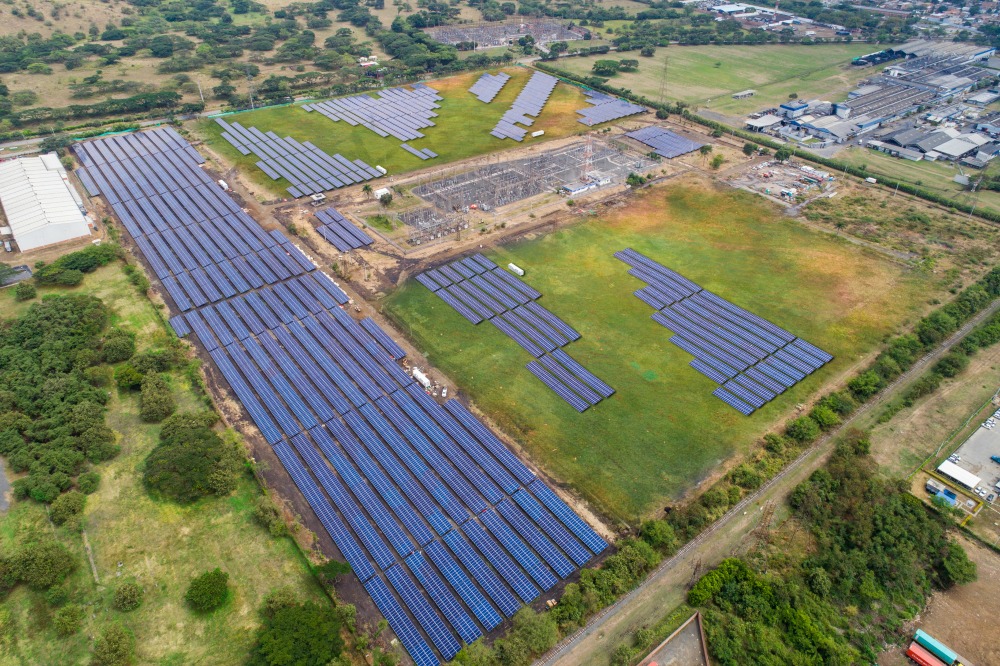To that end, Colombia passed Law 1715 in 2014 to promote the development of renewable energy with the priorities of providing energy security, achieving climate change reductions, and stabilizing electricity prices. The law provides attractive fiscal incentives including a five-year accelerated depreciation, and exemptions of import duties and sales tax.
Early last year, the government announced it would conduct its first non-conventional energy auction for 1 GW worth of projects of equal to or more than 10 MW. The auction, scheduled for December of 2018, was postponed and is now expected in February 2019. Final details are being published to help participants prepare their bids.
Solar and wind generation have played important roles in off-grid applications powering repeater stations, oil and gas platforms, and homes for decades in Colombia. The negative effect of “El Niño” on hydro plants and rising energy costs make it imperative for Colombia to diversify its energy mix and use its other abundant domestic energy resources. For many, the time for Colombia to step up the development of its rich renewable resources is long overdue.
But despite the country’s unique set of market conditions, there is a question of whether or not investors will flock to the auction with winning offers or will they instead choose to sit out in hopes of more appealing terms in future rounds. This is a real question, because the renewable industry has surprised the world lately by setting new record low bid prices at almost every auction worldwide.
However, if energy contract conditions do not align with investor expectations, external forces such as low cost of capital and technology pricing will have to bridge the gap to achieve the auction’s successful outcomes, as seen lately, particularly in Latin America.
Chile, Argentina and Mexico have had very favorable results with their renewable energy auctions in the last five years, with oversubscribed participation and prices below expectations. According to the November 2017 pv magazine report: “Chile’s auction concludes with average price of US$32.5/MWh” related to the Chilean auctions, the first round resulted in an average price of USD$79/MWh in 2015, which was thought as low, and USD$32/MW in the 2017 auction.
Argentina’s first auction for 1 GW in 2016 attracted more than 6 GW worth of bids at an average price of about USD$59/MWh. The second round the following year saw more than 9 GW offered at about US$43/MWh, according to the Ministry of Energy and Mines.
But, Mexico moved the price bar even lower in 2017 by achieving US$20.47 USD/MWh in its third round, according to CENACE, the Mexican government agency in charge of organizing the auctions. Indeed, in Mexico market participants and observers argued that the country’s second auction could not beat the extremely low price of US$40/MWh achieved during the first round. All three countries mentioned above boast of achieving their renewable energy goals at a bargain.
Solar and wind equipment prices have been falling by double digits over the past five years, and investor confidence in renewable technologies has increased, which allowed for bold pricing at the benefit of the off-takers. In addition to clear and consistent rules, and favorable contract conditions, market conditions with regards to equipment price and availability have no doubt contributed to the success of these three markets.
Eyes to Colombia
Now renewable energy investors have their eyes on Colombia. Will the upcoming auction be able to seize similarly favorable global market conditions and repeat the successes seen in Chile, Argentina and Mexico?
Further assessment of the Colombian auction, and particularly the contract terms could provide insights. Contract terms for the new renewable energy projects will be 12 years and the denomination is to remain in Colombian pesos in Colombia for the winning bids, typical of its wholesale electricity market.
Conversely, in Chile, Argentina and Mexico, contract terms have been 20 years, which is also standard for large-scale renewable energy contracts worldwide. Mexico did keep its conventional 15-year contract terms for the sale of electricity, but added five years to the sale of clean energy credits attached to the projects.
At this stage, it appears that the first auction and terms in Colombia add currency risk, which could discourage many investors. However, solar and wind equipment prices have fallen even lower since the latest Mexican auction, which could give cover to investors. It is not out of the realm of possibility that bids at prices competitive with conventional energy in Colombia will be seen at the auction next month.
Colombia may not see prices lower than Mexico and bidders may not swarm to the auction, but as long as the deals offered compete with the current sources of energy and acceptable bids total 1 GW, success will be achieved. A paradigm shift may be about to occur and generators of renewable energy may show their flexibility in the market, assuming that investor confidence remains strong relying on low equipment costs to cover most of their risks.
Given the country's natural resources, especially wind and solar, Colombia could successfully achieve its goals to diversify its energy matrix and meet its emission reduction targets on time. The renewable energy market can show its resiliency, yet again. If not, it may be back to the drawing board for government officials and policy planners. And more prayers for rain.
The authors
 Cecilia Aguillon is the Director of the Energy Transition Initiative at the Institute of the Americas, an impartial and independent non-profit organization promoting dialogue and collaboration across the Western Hemisphere to foster sound public policies and to advance sustainable inclusive economic growth and prosperity. She enables public-private dialogues to develop sustainable renewable energy markets. Cecilia worked at Kyocera Solar, Inc. in California on Business Development and Government Relations for 18 years. She worked with policy makers on designing solar energy programs and renewable portfolio standards for implementation across the United States, Canada, and Mexico. She developed these initiatives in cooperation with several trade associations throughout the United States. She served on the board of the California Solar Energy Industries Association (CalSEIA) and participated in the design and implementation of the California Solar Initiative. She is currently on the board of the Climate Action Campaign working to implement sustainable energy programs for San Diego, California.
Cecilia Aguillon is the Director of the Energy Transition Initiative at the Institute of the Americas, an impartial and independent non-profit organization promoting dialogue and collaboration across the Western Hemisphere to foster sound public policies and to advance sustainable inclusive economic growth and prosperity. She enables public-private dialogues to develop sustainable renewable energy markets. Cecilia worked at Kyocera Solar, Inc. in California on Business Development and Government Relations for 18 years. She worked with policy makers on designing solar energy programs and renewable portfolio standards for implementation across the United States, Canada, and Mexico. She developed these initiatives in cooperation with several trade associations throughout the United States. She served on the board of the California Solar Energy Industries Association (CalSEIA) and participated in the design and implementation of the California Solar Initiative. She is currently on the board of the Climate Action Campaign working to implement sustainable energy programs for San Diego, California.
 Jeremy Martin is Vice President, Energy & Sustainability at the Institute of the Americas, an inter-American public policy think-tank located at the University of California San Diego (UCSD). The Institute of the Americas Energy & Sustainability Program works to foster a deeper understanding of the most critical energy issues facing the Western Hemisphere. Jeremy spends his time delving into the geopolitics of energy and closely following energy industry trends and policy issues across the Americas, and is a frequent commentator and writer on Latin American and energy issues. Jeremy has testified before the US Congress on energy issues in Latin America, teaches a graduate course in Latin American Energy Policy at UCSD and the University of San Diego (USD) and serves on the Board of Advisors for the Inter-American Dialogue’s Energy Advisor newsletter. He also serves on the Board of Directors of the San Diego Diplomacy Council and is a member of the host committee for the Crohn’s & Colitis Foundation San Diego Chapter annual Bet on Cures event.
Jeremy Martin is Vice President, Energy & Sustainability at the Institute of the Americas, an inter-American public policy think-tank located at the University of California San Diego (UCSD). The Institute of the Americas Energy & Sustainability Program works to foster a deeper understanding of the most critical energy issues facing the Western Hemisphere. Jeremy spends his time delving into the geopolitics of energy and closely following energy industry trends and policy issues across the Americas, and is a frequent commentator and writer on Latin American and energy issues. Jeremy has testified before the US Congress on energy issues in Latin America, teaches a graduate course in Latin American Energy Policy at UCSD and the University of San Diego (USD) and serves on the Board of Advisors for the Inter-American Dialogue’s Energy Advisor newsletter. He also serves on the Board of Directors of the San Diego Diplomacy Council and is a member of the host committee for the Crohn’s & Colitis Foundation San Diego Chapter annual Bet on Cures event.
The views and opinions expressed in this article are the author’s own, and do not necessarily reflect those held by pv magazine.
This content is protected by copyright and may not be reused. If you want to cooperate with us and would like to reuse some of our content, please contact: editors@pv-magazine.com.



It’s interesting the time line and cost for large scale projects. The article mentions power generated at USD of $79/MWh in 2015 dropping to a “second round” of USD $32/MWh in 2017. One must keep in mind that this cost does not require commodity fuels to generate power. Price fluctuations for each MWh of electricity produced is pretty much set, either the sun is shining or it is not.
The game changing addition to past projects of solar PV is energy storage. With many solar PV construction companies bidding the solar PV or wind generation project with energy storage as part of the project price. In 2017 The 100MW TESLA energy storage system installed across a wind farm in Australia was said to cost USD $207/kWh of storage, just a few years ago it would have cost USD $1,000/kWh of storage. The construction of large flow battery energy storage in China will drive large scale energy storage around the World.